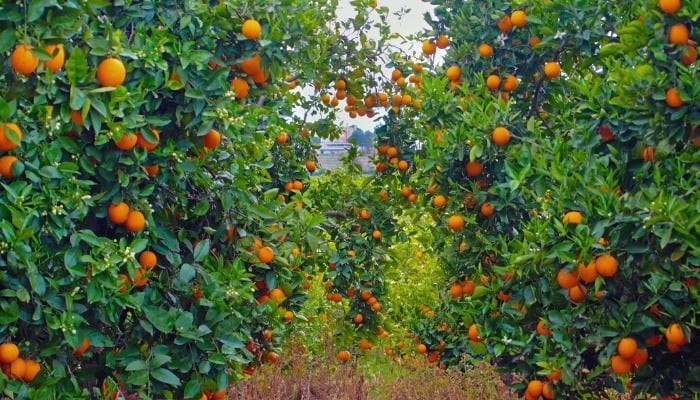Houston can be found in USDA Climate Zone 9, which typically experiences temperatures above 45 degrees Fahrenheit.
This climate is ideal for many orange and citrus tree varieties to grow and thrive year-round.
What are the best orange trees for Houston? The best orange trees for Houston are the Valencia orange trees, navel orange trees, blood orange trees, mandarin orange trees, Hamlin orange trees, sour orange trees, Marrs orange trees, and pineapple orange trees. Other citrus tree varieties can also thrive in Houston.
In this article, we take a closer look at eight of the best orange trees for Houston, as well as seven other citrus tree options, so be sure to stick around!
Best Orange Trees To Grow in Houston
Orange tree varieties in Houston can provide farmers and gardeners with fruity treats year round. Here are the eight best orange trees to grow in Houston:
1. Valencia Orange

Valencia orange trees are among the most widely grown orange trees. They produce the juiciest oranges of all varieties and are the only orange trees that bear fruit in the summer.
Valencia oranges are generally sweet and aromatic, which makes them great for juice. The fruit itself contains few seeds, and its peel is harder to peel than other orange varieties.
The peel also has an intense orange color but may discolor or become sunburned in very high temperatures above 100℉. Luckily, temperatures this high are uncommon in Houston.
- Botanical name: Citrus sinensis ‘Valencia’
- Popular varieties: Delta Valencia, Dom João Olinda Valencia, Cutter Valencia, Frost Valencia, Midknight Valencia, and Campbell Valencia.
- Average tree size: 12 to 20 ft. tall
- Average fruit size: 2.7 to 3 inches in diameter
- Cold hardiness: 35℉
Check Price On FastGrowingTrees.com
2. Navel Orange
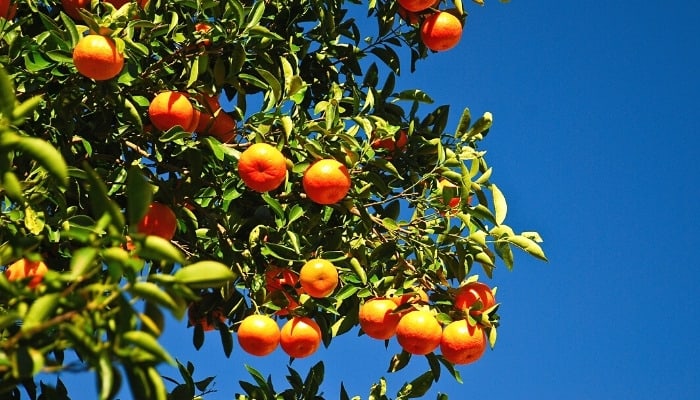
Navel orange trees are widely cultivated for their sweet, juicy, and seedless oranges. These oranges are the ones you find in almost any grocery store, including in Houston.
You can also easily identify them by the partially formed hole in the shape of a belly button at the bottom of the fruit.
Unlike the Valencia orange, navel oranges are thick-skinned, so they’re easy to peel. This makes them perfect for eating.
- Botanical name: Citrus x sinensis
- Popular varieties: Cara Cara, Washington Navel, Fukumoto, Lane Late Navel, Robertson, and Skaggs Bonanza
- Average tree size: 30 ft. tall
- Average fruit size: 3 inches in diameter
- Cold hardiness: 28℉
Check Price On FastGrowingTrees.com
3. Blood Orange
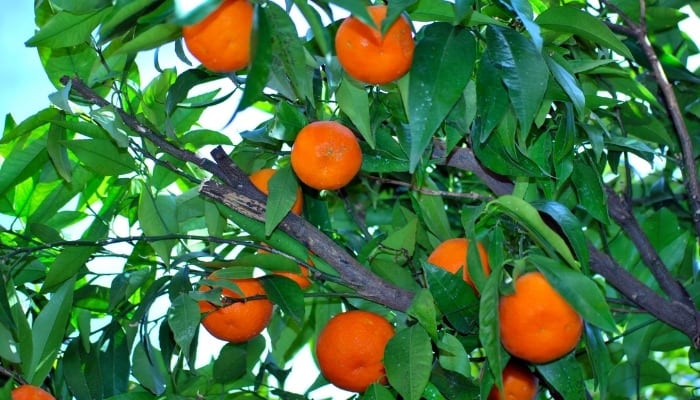
Blood orange trees came about as a mutation of sweet orange trees in Italy as early as the 1600s.
We now have several blood orange tree varieties that produce juicy, slightly sour fruit with vibrant red to deep maroon flesh.
Even when you squeeze out the fruit, the juice that comes out is a blood-red color.
One popular blood orange variety in Houston is Moro, which is also known as Connoisseur’s Citrus.
It’s known for its bright orange skin, dark burgundy flesh, and a punchy blend of sweet and tart flavor.
- Botanical name: Citrus x sinensis ‘Blood Orange’
- Popular varieties: Moro, Sanguinello, and Tarocco
- Average tree size: 10 to 15 ft. tall
- Average fruit size: 2 to 3 inches in diameter
- Cold hardiness: 27℉
Check Price On FastGrowingTrees.com
4. Mandarin Orange
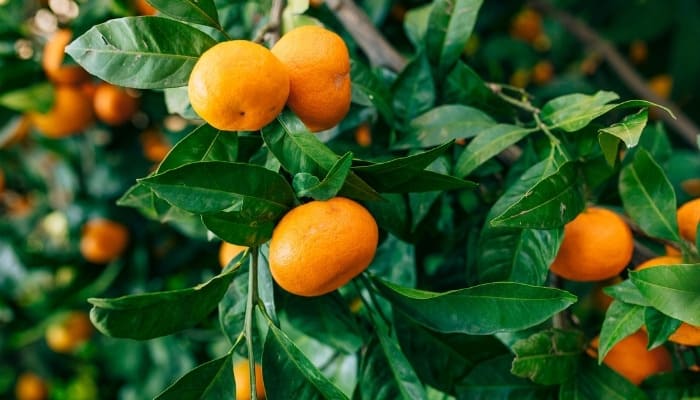
Mandarin orange trees produce small, juicy, slightly oblate oranges that have vibrant orange or reddish-orange thin peels.
These trees are among the most frost tolerant, so even an unusually cold winter in Houston is unlikely to harm them.
Mandarin oranges are known for their sweet yet complex flavor profile that has a hint of vanilla and spice.
They’re typically less acidic than other orange varieties—there are some tart mandarin orange varieties, though.
- Botanical name: Citrus reticulata
- Popular varieties: Ponkan, Lukan, Kinno, Swatow, Mandelo, and Dekopon
- Average tree size: 25 ft. tall
- Average fruit size: 2 inches in diameter
- Cold hardiness: 20℉
Check Price On FastGrowingTrees.com
5. Hamlin Round Orange
Hamlin round orange trees are a popular orange variety that can produce a high fruit yield as early as October.
The oranges are deliciously juicy, tangy-sweet, and seedless, making them ideal for both eating and juicing. Their peels are round and smooth, with a dull orange to dark yellow color.
That said, these orange trees are a bit of an enigma and can be difficult to find. They’re, however, well suited to Houston’s climate, so if you can find and grow a tree, it’ll be worth the time and effort.
- Botanical name: Citrus sinensis ‘Hamlin’
- Popular varieties: Hamlin (Louisiana) Sweet Orange
- Average tree size: 12 to 14 ft. tall
- Average fruit size: 2 inches in diameter
- Cold hardiness: 18℉
6. Sour Orange
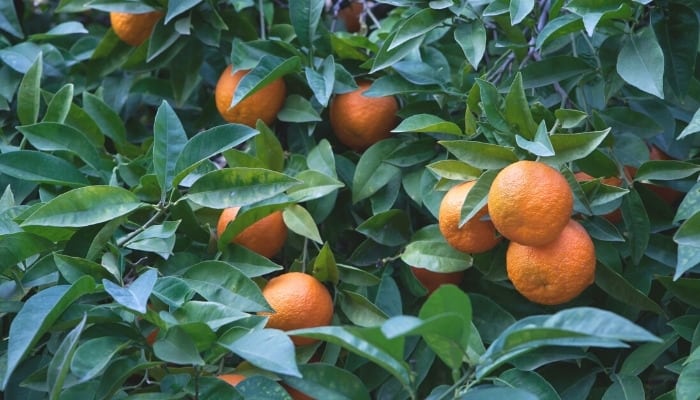
Sour oranges, as the name suggests, are a type of orange that has a high acidic content, which makes it taste bitter.
This bitterness is unpalatable to many people, so their peels are often used to make marmalades.
However, some sour orange varieties, such as Bergamot oranges, are so acrid that they can’t even be used in marmalade.
Instead, they’re more valued for their oil, which can be used in perfume and tea.
You can find them in Houston, but they’re less common than other orange varieties.
- Botanical name: Citrus x aurantium
- Popular varieties: African, Argentine, Bergamot, Bigaradier apepu, Chinotto, Daidai, Seville, and Tunis
- Average tree size: 20 ft. tall
- Average fruit size: 3 inches in diameter
- Cold hardiness: 20℉
7. Marrs Orange
Marrs orange trees are a native Texan orange variety that appeared as a sport (genetic mutation) in a group of navel orange trees.
It’s believed that they first occurred in 1927 at the home of O. F. Marrs from Donna, Texas—hence the name.
Marrs oranges are medium size, round to slightly squashed, and finely pitted. They have juicy, often seedy flesh, and they taste quite sweet due to their low acidity levels.
- Botanical name: Citrus x aurantium L. – Citrus sinensis (L.)
- Popular varieties: None
- Average tree size: 12 ft. tall
- Average fruit size: 3 inches in diameter
- Cold hardiness: 26℉
8. Pineapple Orange
Pineapple orange trees are an heirloom variety that produces vibrant orange-colored fruit on the inside and out.
When the fruit ripens, the peel color turns a deep reddish-orange, and the juices are dark orange.
The oranges are juicy and rich, with a sweet flavor profile that has nothing to do with pineapples. It was actually given the name “Pineapple” because of its delicate fragrance.
- Botanical name: Citrus x sinensis ‘Pineapple Orange’
- Popular varieties: Queen Pineapple Orange, Seedless Pineapple, Plaquemines, Belvedere, Gem, Ridge Pineapple, and Letaba
- Average tree size: 12 to 14 ft. tall
- Average fruit size: 2.75 to 3 inches in diameter
- Cold hardiness: 26℉
More Citrus Trees for the Houston Area
Citrus trees laden with oranges, lemons, limes, and grapefruits are a common sight around Houston.
Obviously, oranges are not the only citrus trees that grow and thrive in the Houston climate. Here’s a look at some other options that may interest you.
Lemons
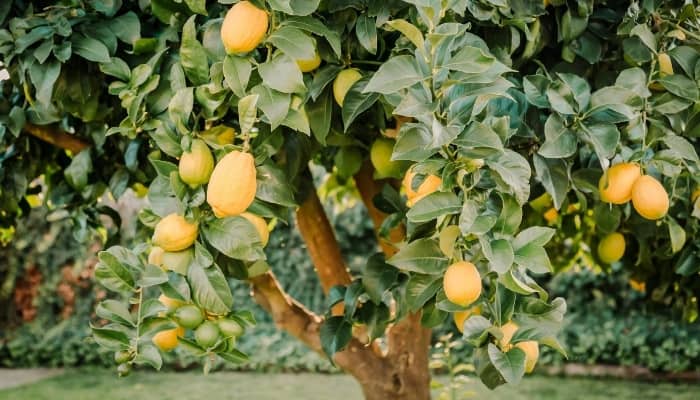
While not all lemon varieties can thrive in Houston, most heirloom lemon varieties do. The Meyer lemon, also known as the valley lemon, is probably the most common in this sub-tropical region.
This lemon tree grows more like a shrub and is known for its fragrant white blossoms. It’s slightly shorter than regular tree lemons, growing to a height of 6 to 8 feet.
The lemon, on the other hand, is larger than regular lemons, measuring around 3 inches in diameter. It’s also moderately acidic and much sweeter than regular lemons.
- Botanical name: Citrus limon
- Popular varieties: Eureka and Lisbon
- Average tree size: 10 to 25 ft. tall
- Average fruit size: 2 inches
- Cold hardiness: 27℉
Check Price On FastGrowingTrees.com
Limes
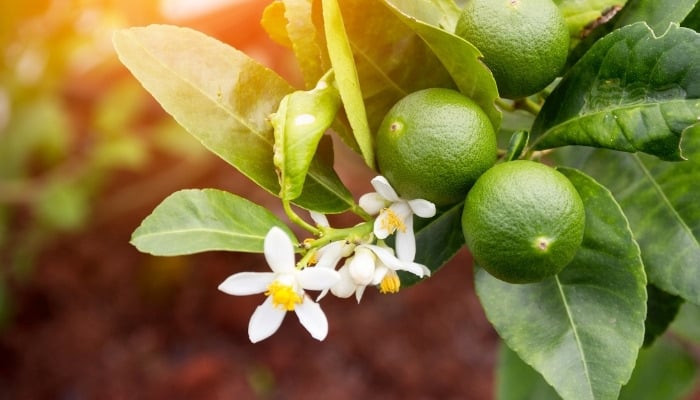
Similar to lemon trees, lime trees don’t do well in subtropical climates, but some varieties can.
Mexican lime trees, also known as Key lime, are regarded as one of the best citrus trees for Houston because they’re often the first to ripen, which is around mid-August.
These trees can reach a height of 13 feet and produce golf-ball-sized yellow-green limes. The limes are tarter and more floral than regular limes, but they have more seeds.
- Botanical name: Citrus x aurantiifolia
- Popular varieties: Castelo Lime, Kaffir Lime, Australian Finger Lime, Persian Lime, and Bearss
- Average tree size: 15 to 20 ft. tall
- Average fruit size: 1.2 to 2.4 inches in diameter
- Cold hardiness: 50℉
Check Price On FastGrowingTrees.com
Grapefruits
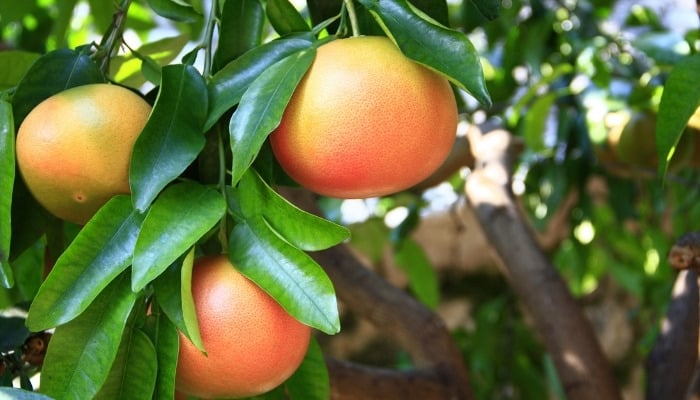
Red grapefruits are true American natives that hail from Texas, so they grow and thrive in the Houston climate perfectly.
Rio Red grapefruit trees are among the common grapefruit varieties that you can grow in Houston. They bear the juiciest and sweetest grapefruits, which is why they’re so popular.
In addition, the tree produces some of the most fragrant blossoms of all citrus trees.
Nevertheless, the Rio Red tree is slightly shorter than standard grapefruit trees, reaching a height of 15 to 20 feet tall.
It also ripens the slowest of all citrus trees, so you expect the most delicious grapefruits from November to March.
- Botanical name: Citrus x paradisi
- Popular varieties: White Grapefruit, Pink Grapefruit, Red Grapefruit, Ruby Red Grapefruit, Golden Grapefruit, and Bloomsweet Grapefruit
- Average tree size: 18 to 25 ft. tall
- Average fruit size: 4 to 6 inches in diameter
- Cold hardiness: 26℉
Check Price On FastGrowingTrees.com
Tangerines

Tangerines, often confused with mandarins, are a specific variety of mandarin oranges. They’re sweeter with a slight tang. The rinds are also thinner.
Tangerines make excellent choices for the Houston climate. They’re not only more tolerant of cold weather, but they also love the sun, making Houston an ideal year-round residence.
- Botanical name: Citrus tangerina
- Popular varieties: Dancy and Sunburst
- Average tree size: 10 to 15 ft. tall
- Average fruit size: 2 to 4 inches in diameter
- Cold hardiness: 21℉
Tangelos
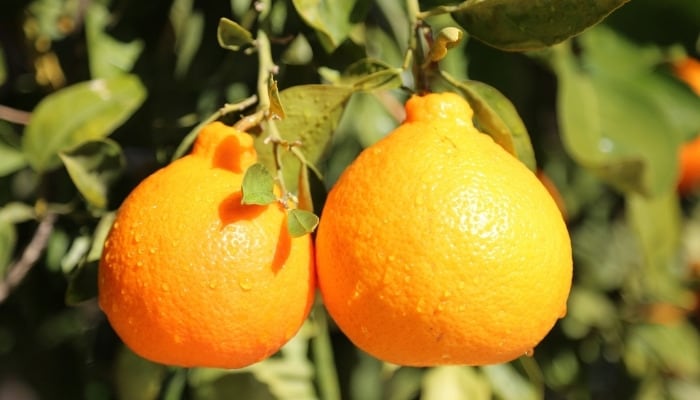
Tangelos are the offspring of a grapefruit and a tangerine cross. The fruit looks a lot like an orange but with a uniquely shaped bulbous stem end.
It’s super juicy and aromatic, with a slightly acidic to sweet flavor. The skin is also a deep orange and semi-thick, so it’s easy to peel.
- Botanical name: Citrus x tangelo
- Popular varieties: Honeybell, Orlando, and Minneola
- Average tree size: 8 to 12 ft. tall
- Average fruit size: 3 inches in diameter
- Cold hardiness: 28℉
Check Price On FastGrowingTrees.com
Kumquats
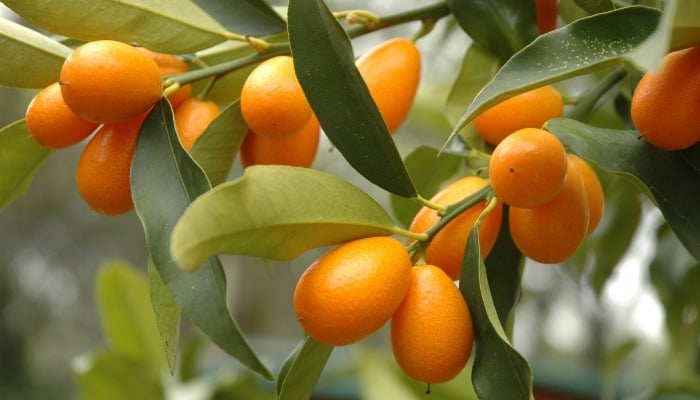
Kumquats, also spelled Cumquat, are small, easy-to-grow, fruit-bearing trees. They belong to the same family as oranges, lemons, and other citrus trees.
The fruits are yellowish-orange and more oval. Unlike other citrus varieties, kumquats have sweet, edible skin and slightly tart flesh.
- Botanical name: Citrus japonica
- Popular varieties: Centennial Variegated, Marumi, Meiwa, Nagami, and Nordmann Seedless
- Average tree size: 7 to 12 ft. tall
- Average fruit size: 1 inch in diameter
- Cold hardiness: 18℉
Check Price On FastGrowingTrees.com
Calamondin
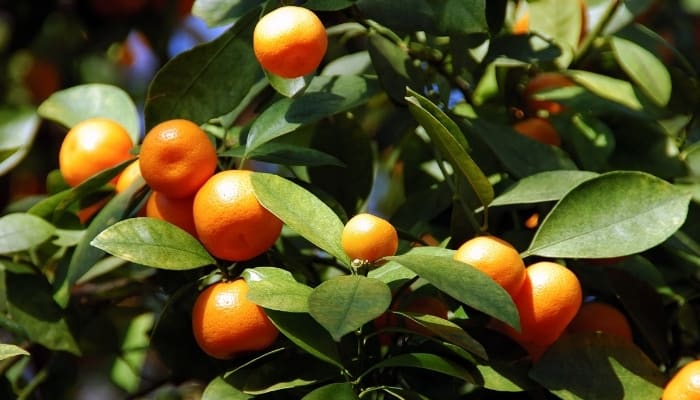
Calamondins are citrus trees that were brought to the United States from China. They’re a cross between mandarin orange and kumquat trees.
The fruit’s peel is thin, smooth, and yellow to yellow-orange. The fruit itself is quite acidic, like lemon and lime, so it’s often used in marmalades or as a dressing.
It’s worth noting that while calamondins have the lowest cold hardiness on this list, it’s still better to keep them indoors to prevent stunted growth and frozen fruit.
- Botanical name: Citrus x microcarpa
- Popular varieties: Calamondin Sport
- Average tree size: 10 to 20 ft. tall
- Average fruit size: 1 inch in diameter
- Cold hardiness: 16℉
Related Questions:
When Should I Buy Citrus Trees?
You should buy citrus trees as soon as the ground thaws in the early spring. This allows them to adjust to their new environment and establish themselves during the warm growing season.
Hypothetically, you can buy citrus trees in the fall, but you have to consider bringing them indoors before the cold weather sets in. A winter freeze can stunt them before they have a chance to grow.
Can You Grow Avocados in Texas?
It’s not common to grow avocados in Texas, but it’s possible. The reason is that while most people wouldn’t describe a Texas winter as cold, avocado trees would beg to differ.
Avocado trees thrive in warm, subtropical climates with temperatures ranging from 68 to 75℉.
Because these trees require these warm temperatures all year, Texas winter temperatures ranging from 24 to 50℉ may be too cold for an avocado tree to grow properly.
That said, with a little extra effort, you can grow avocados in Texas. Indeed, the Lower Rio Grande Valley is home to a plethora of backyard avocado trees.
Conclusion
Numerous orange and citrus tree species and hybrids can acclimate and thrive in Houston’s subtropical environment.
Once you’ve found the ideal location for a citrus tree, you can choose from the best orange trees for Houston to ensure your tree grows and bears fruit as soon as possible.
Sources:
https://idtools.org/id/citrus/citrusid/
http://citruspages.free.fr/index.php
https://www.missouribotanicalgarden.org/
https://citrusvariety.ucr.edu/index.html
https://aggie-horticulture.tamu.edu/
https://extension.arizona.edu/sites/extension.arizona.edu/files/pubs/az1222.pdf

